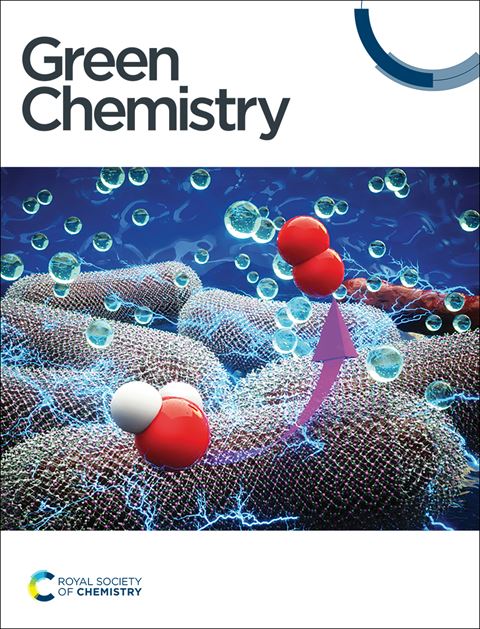揭示动态表面转变:mo掺杂fe基mof作为下一代析氧催化剂†
IF 9.3
1区 化学
Q1 CHEMISTRY, MULTIDISCIPLINARY
引用次数: 0
摘要
释放金属有机框架(mof)在水分解应用中的全部潜力需要创新的策略来提高其催化效率和稳定性。在这里,我们引入了一种具有独特的二维纳米片和板状形貌的mo掺杂铁基MOF (MoFe-NH2-BDC),以彻底改变析氧反应(OER)。Mo的加入优化了电子性能,加速了电荷转移,并动态地将催化剂表面重建为高活性的FeOOH物种,确保了长期的性能。这种新一代电催化剂在20 mA cm−2下实现了254 mV的超低过电位,其快速塔菲尔斜率为66 mV dec−1,超过了传统的RuO2催化剂。Operando Raman和ATR-FTIR光谱分析表明,Mo促进了吸附质演化机制(AEM),稳定了中间体,提高了反应动力学。在实际的双电极系统中,MoFe-NH2-BDC(+)||Pt/C(−)在100 mA cm - 2下表现出1.58 V的优异电池电压,保持85小时的稳定性。这些结果强调了Mo掺杂在mof中的革命性影响,为可持续能源应用的高效,耐用和可扩展的电催化剂铺平了道路。本文章由计算机程序翻译,如有差异,请以英文原文为准。
Unveiling dynamic surface transformations: Mo-doped Fe-based MOFs as next-generation oxygen evolution catalysts†
Unlocking the full potential of metal–organic frameworks (MOFs) for water-splitting applications requires innovative strategies to enhance their catalytic efficiency and stability. Here, we introduce a Mo-doped Fe-based MOF (MoFe-NH2-BDC) with a unique 2D nanosheet and plate-like morphology to revolutionize the oxygen evolution reaction (OER). Mo incorporation optimizes electronic properties, accelerates charge transfer, and dynamically reconstructs the catalyst surface into highly active FeOOH species, ensuring long-term performance. This next-generation electrocatalyst achieves an ultra-low overpotential of 254 mV at 20 mA cm−2, with a rapid Tafel slope of 66 mV dec−1, surpassing conventional RuO2 catalysts. Operando Raman and ATR-FTIR spectroscopy reveal that Mo facilitates an adsorbate evolution mechanism (AEM), stabilizing intermediates and boosting reaction kinetics. In a practical two-electrode system, MoFe-NH2-BDC(+)||Pt/C(−) demonstrates an exceptional cell voltage of 1.58 V at 100 mA cm−2, maintaining stability for 85 h. These results underscore the transformative impact of Mo doping in MOFs, paving the way for highly efficient, durable, and scalable electrocatalysts for sustainable energy applications.
求助全文
通过发布文献求助,成功后即可免费获取论文全文。
去求助
来源期刊

Green Chemistry
化学-化学综合
CiteScore
16.10
自引率
7.10%
发文量
677
审稿时长
1.4 months
期刊介绍:
Green Chemistry is a journal that provides a unique forum for the publication of innovative research on the development of alternative green and sustainable technologies. The scope of Green Chemistry is based on the definition proposed by Anastas and Warner (Green Chemistry: Theory and Practice, P T Anastas and J C Warner, Oxford University Press, Oxford, 1998), which defines green chemistry as the utilisation of a set of principles that reduces or eliminates the use or generation of hazardous substances in the design, manufacture and application of chemical products. Green Chemistry aims to reduce the environmental impact of the chemical enterprise by developing a technology base that is inherently non-toxic to living things and the environment. The journal welcomes submissions on all aspects of research relating to this endeavor and publishes original and significant cutting-edge research that is likely to be of wide general appeal. For a work to be published, it must present a significant advance in green chemistry, including a comparison with existing methods and a demonstration of advantages over those methods.
 求助内容:
求助内容: 应助结果提醒方式:
应助结果提醒方式:


